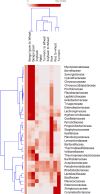Bacterial microbiome associated with cigarette beetle Lasioderma serricorne (F.) and its microbial plasticity in relation to diet sources
- PMID: 38241343
- PMCID: PMC10798513
- DOI: 10.1371/journal.pone.0289215
Bacterial microbiome associated with cigarette beetle Lasioderma serricorne (F.) and its microbial plasticity in relation to diet sources
Abstract
Insect-microbial symbiosis contributes positively to the physiology of the insect and diet is considered as one important factor determining microbial symbiosis. In this study, we have characterized the microbiota of cigarette beetle, Lasioderma serricorne (Fabricius) on different diets and phases. The beetles were reared on different diet sources (exposed phase) for six generations and were reverted to their natal source (reverted phase) and further maintained for six more generations. The bacterial diversity and richness were higher in the exposed phase and once reverted to the natal source, the microbial abundance has re-assembled according to the natal diet source. There was re-assemblage of microbial composition in accordance to the diet and the bacterial cells are able to establish and proliferate on reverting to their natal source. The bacterial composition of the beetle was mainly dynamic and not transient where the bacterial cells were maintained at low abundance and were re-established according to the diet source. Overall, we found that the microbiota of cigarette beetle to be dynamic and bacterial composition to re-assemble in a diet-specific manner. The study provides insights on diet associated microbial plasticity of cigarette beetle and a further comprehensive understanding on mechanisms involved in microbial plasticity will help develop novel pest management strategies for this invasive insect pest.
Copyright: © 2024 Srinivasan et al. This is an open access article distributed under the terms of the Creative Commons Attribution License, which permits unrestricted use, distribution, and reproduction in any medium, provided the original author and source are credited.
Conflict of interest statement
The authors have declared that no competing interests exist
Figures








Similar articles
-
Biology, Ecology, and Control of Lasioderma serricorne (F.) (Coleoptera: Anobiidae): A Review.J Econ Entomol. 2019 May 22;112(3):1011-1031. doi: 10.1093/jee/toy428. J Econ Entomol. 2019. PMID: 30698784 Review.
-
Innate positive chemotaxis to paeonal from highly attractive Chinese medicinal herbs in the cigarette beetle, Lasioderma serricorne.Sci Rep. 2019 May 6;9(1):6995. doi: 10.1038/s41598-019-43198-3. Sci Rep. 2019. PMID: 31061503 Free PMC article.
-
Adults of Lasioderma serricorne and Stegobium paniceum (Anobiidae: Coleoptera) Are Attracted to Ultraviolet (UV) Over Blue Light LEDs.J Econ Entomol. 2017 Aug 1;110(4):1911-1915. doi: 10.1093/jee/tox127. J Econ Entomol. 2017. PMID: 28498915
-
A survey of Lasioderma serricorne (Fabricius) in Japanese Dental Clinics.Biocontrol Sci. 2019;24(2):117-121. doi: 10.4265/bio.24.117. Biocontrol Sci. 2019. PMID: 31204356
-
Microbial bases of herbivory in beetles.Trends Microbiol. 2025 Feb;33(2):151-163. doi: 10.1016/j.tim.2024.08.004. Epub 2024 Sep 25. Trends Microbiol. 2025. PMID: 39327210 Review.
References
MeSH terms
LinkOut - more resources
Full Text Sources

